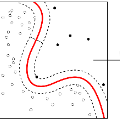We propose a novel reconstruction-based model for anomaly detection, called Y-GAN. The model consists of a Y-shaped auto-encoder and represents images in two separate latent spaces. The first captures meaningful image semantics, key for representing (normal) training data, whereas the second encodes low-level residual image characteristics. To ensure the dual representations encode mutually exclusive information, a disentanglement procedure is designed around a latent (proxy) classifier. Additionally, a novel consistency loss is proposed to prevent information leakage between the latent spaces. The model is trained in a one-class learning setting using normal training data only. Due to the separation of semantically-relevant and residual information, Y-GAN is able to derive informative data representations that allow for efficient anomaly detection across a diverse set of anomaly detection tasks. The model is evaluated in comprehensive experiments with several recent anomaly detection models using four popular datasets, i.e., MNIST, FMNIST and CIFAR10, and PlantVillage.
翻译:我们提出了一个新的异常点探测重建模型,称为Y-GAN。该模型由Y型自动编码器组成,在两个不同的潜伏空间中代表图像。第一个模型捕捉有意义的图像语义,这是代表(正常)培训数据的关键,而第二个编码是低水平残余图像特征。为了确保双重表述,将相互排斥的信息编码为一种分解程序。此外,还提出了一个新的一致性损失,以防止潜伏空间之间的信息渗漏。该模型仅使用正常的培训数据进行单级学习培训。由于将语义相关和剩余信息分开,Y-GAN能够获取信息性的数据表述,从而能够对不同异常点探测任务组合进行有效的异常点探测。该模型在综合实验中进行了评估,最近使用四种流行数据集(即MNIST、FMNIST和CIFAR10)和PlantVillage的异常点探测模型进行了多次全面试验。




